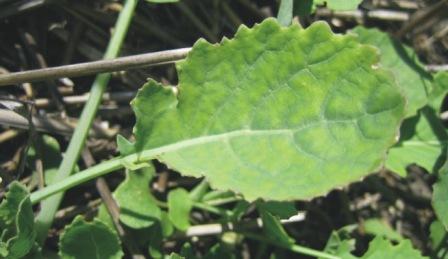Sulphur is an essential nutrient element for plant as well as animal kingdom. It often accumulates in areas with volcanic activity, and mostly found in organic form in soils. Though S is a secondary nutrient element, its uptake is 9-15% of N uptake and similar to that of P uptake.
Crucifers are found to have much more requirement of S than other crops primarily because of oil production and other essential S containing volatile compounds.
Sulphur deficiency is wide spread across the world soils (Scherer, 2009). Intensification of agriculture with high yielding varieties and multiple cropping coupled with use of high analysis sulphur free fertilizers along with restricted or no use of organic manures have accrued in depletion of soil sulphur reserve.
Apart from that the reduction of sulphur dioxide emission from power plants and various industrial sources, the decreasing use of sulphur containing fungicides and pesticides and also injudicious use of irrigation water are the most important reasons for sulphur deficiency.
Importance of Sulphur in Oilseed production:
The importance of sulphur in oilseed production is obvious because of the following reasons-
- Required for the synthesis of sulphur containing amino acids methionine (21%), cysteine (26%) and cystine (27%), which are essential components of protein. Approximately 90% of plant sulphur is present in these amino acids (Tandon and Messick, 2002). Also needed for the synthesis of metabolites such as coenzyme A, biotin, thiamin or vitamin B1 and glutathione.
- Involved in the formation of chlorophyll, glucosides and glucosinolates (mustard oils), activation of enzymes and sulphydryl (-SH) linkages that are the source of pungency in oils.
- Increases root growth and stimulate seed formation.
Factors affecting sulphur availability in soils:
Availability of sulphur in soils is strongly influenced by the soil organic moiety and other soils properties. A few of these are discussed as follows-
Soil texture: Sandy soils owing to its low organic matter content and low water holding capacity sulphate-S is leached with irrigation waterto deeper soil layers. So this type of soilis found to be deficient in sulphur.
Soil organic matter content: Organic matter is the major reservoir for S as a higher fraction of S is associated with organic matter. However, the availability of S depends upon the mineralization-immobilization turnover (MIT) of the soils rather than the organic matter content of the soil.
Soil temperature: The conversion of various forms of S to the sulphate-S form is a microbial process which depends upon the soil temperature. Temperature in the mesophilic range (25- 350C) is beneficial while low soil temperatures slow this process.
Drainage: Microbial conversion of organic S to sulphate-S requires free oxygen and aeration. The process slows down when the soil is saturated with water.
Deficiency symptoms in oilseed crops:
When plants have inadequate sulphur first they suffer from hidden hunger. When its deficiency becomes severe, the plant shows typical deficiency symptoms. Crop growth suffers at such levels and responds well to sulphur application through fertilizers. The critical level of S content varies with the crops and the stage of development.
Recognition of characteristics symptoms is often the first step in diagnosis of sulphur deficiency. Sulphur deficiency symptoms in many ways resembles to those of nitrogen deficiency i.e. the leaves become pale-yellow or light green. Unlike nitrogen, sulphur deficiency symptoms first appear on younger leaves.
Plants deficient in sulphur are small and spindly with short and slender stalks, their growth is retarded. Typical symptoms of sulphur deficiency have also been identified for different oilseed crops which is depicted in table.1
Table.1 Typical symptoms of sulphur deficiency in oilseed crops
| Crops | Deficiency Symptoms |
| Rapeseed-Mustard | Deficiency symptoms first occur on younger leaves. Chlorosis of leaf margins, development of purple pigmentation. Inward curling of young leaf lamina giving rise to a cupped appearance followed by scorching and withering. |
| Groundnut | Stunted growth, and general yellowing of plants. Delay in maturity. Acute sulphur deficiency causes the entire plant to turn yellow. |
| Sunflower | Yellowing spreads from the base to the apex. Growth of plants is reduced. The size of capitulum is severely restricted. Inflorescence may remain covered within the bracts. Maturity of flowers is often delayed |
| Sesame | Sulphur deficiency produces smaller new leaflets with yellow and erect petioles than the normal plant growth. Plants are smaller in size and modulation is poor. |
| Canola | Younger leaves are lime-green, often with interveinal chlorotic mottles and pale leaf margins. Leaves are cupped or roll inwards and become thickened and crisp and brittle. |
Fig. Typical deficiency symptoms of some of the crops
 |
 |
 |
|
Cup shaped leaves of Canola |
Yellowing of Groundnut leaves |
Chlorotic leaf margin of Rapeseed |
How to correct S-deficiency?
If diagnostic tools (soil testing and plant tissue test) suggest a need for additional S, there are many excellent sources of S that can be used to supplement the soil supply. Most commonly used are as follows-
Elemental Sulphur (99% S): Elemental S is an excellent source of S, but it is insoluble and requires microbial oxidation to SO4= before plants uptake.
Clay-amended Sulfur (90% S): Can be used along with micronutrients in which the acidity produced by sulphuric acids helps in availability of micronutrients.
Gypsum (16 to 18% S): Calcium sulphate (CaSO4·2H2O) is only slightly soluble in water and mainly used as soil ameliorant.
Single Superphosphate (11 to 12% S): Widely used and popular fertilizers. Commonly used as because it adds to soils sulphur as well as phosphorus.
Ammonium Sulphate (24% S): Ammonium sulphate [(NH4)2SO4] is a commonly used fertilizer to supply both N and S.
Potassium Sulphate (17 to 18% S): It is very soluble and makes an excellent source of SO4= for plants.
Potassium Magnesium Sulphate (Langbeinite) (20 to 22% S): It is highly soluble.
The selection of the appropriate source of S will depend on the soil properties such as leaching potential, pH and organic matter content. The requirement for an immediately soluble source of S will also influence the selection of a specific fertilizer source.
How to apply the S fertilizers?
Broadcast or dribble banded, broadcast and subsequent incorporation, band placement, seed placement and banded near the seed are the major methods of application of sulphur fertilizers in soils. Among these methods broadcasting and band placement methods are widely used.
Managing sulphur fertilization in soil using 4R nutrient stewardship principle (Right Source of nutrient applied at the Right Rate, Right Time, and Right Place) is a modern tool to enhance the use efficiency of S-fertilizers.
Scientific management practices can be adopted to avoid the losses of the nutrient element S. A combination of soluble SO4= and elemental S may be useful to provide both an immediate and a prolonged source of plant nutrition.
References:
Scherer H.W. (2009): Sulfur in soils. Journal of Plant Nutrition and Soil Science, 172: 326–335.
Tandon H.L. S. and Messick D. L. (2002): Practical Sulphur Guide. The Sulphur Institute, Washington, D.C. Pp. 20.
Author (s)
Dhaneshwar Padhan1*, Ashim Datta2, Mahasweta Chakraborty1 and Chinmayee Roy3
1Department of Agricultural Chemistry and Soil Science, Bidhan Chandra Krishi Viswavidyalaya, West Bengal- 741252
2Division of Soil and Crop ManagementICAR-Central Soil Salinity Research InstituteKarnal-132 001, Haryana, India
3Department of Soil Science and Agricultural Chemistry, College of Agriculture, OUAT, Bhubaneswar-751003
*E-mail of corresponding author:
